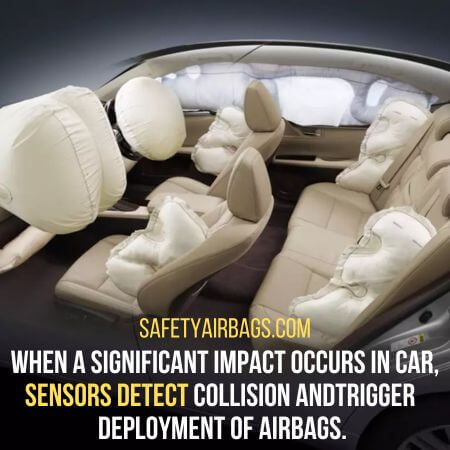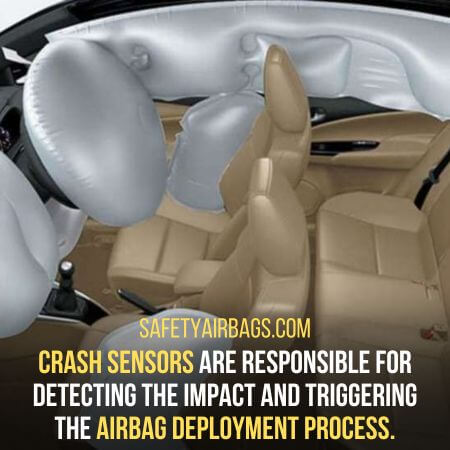When does an airbag deploy? An airbag deploys when a collision is detected, typically involving a significant impact force and deceleration that exceeds a certain threshold.
What Will I learn
An airbag deploys When these thresholds are surpassed; the sensor system triggers the deployment of the airbag.
When Does An Airbag Deploy – Understanding Airbag Deployment
Airbag deployment is a crucial safety feature in vehicles that aims to protect occupants during collisions.
When a significant impact occurs, sensors detect the collision and trigger the deployment of airbags.

Airbag deployment aims to provide a cushioning barrier between the occupants and the vehicle’s interior, reducing the risk of serious injuries.
Several factors influence the triggering of airbag deployment:
1. Impact Angle:
The collision’s severity plays a key role in determining whether airbags will deploy.
Typically, airbags are designed to deploy in moderate to severe collisions where the force exerted on the vehicle surpasses a certain threshold.
The angle at which the vehicle is struck also affects airbag deployment.
Different collisions, such as head-on, side-impact, or rear-end collisions, may require specific airbags to deploy to provide optimal protection to the occupants.
2. Speed of the Vehicle:
The speed of the vehicle at the time of impact influences airbag deployment.
Higher speeds can generate more force during a collision, increasing the likelihood of airbag deployment to protect occupants from potential injuries.
3. Occupant Position and Weight:
Airbag systems are designed to consider the position and weight of the occupants.
This information helps determine the timing and force of airbag deployment to provide appropriate protection.
Factors such as occupant proximity to the airbags, seating position, and presence of child seats are considered.
Components of an Airbag System
Components of an airbag system include airbag modules, Crash sensors, control units, and inflators.
1. Airbag Module:
The airbag module is the central component of the airbag system. It consists of the airbag itself.
It is housed in the steering wheel for the driver and the dashboard or side panels for passengers.
The module also contains the inflator, which generates the gas required to inflate the airbag during deployment rapidly.
2. Crash Sensors:
Crash sensors, also known as impact sensors, are responsible for detecting the impact and triggering the airbag deployment process.

These sensors are strategically placed throughout the vehicle and are designed to respond to rapid deceleration or changes in velocity that indicate a collision.
3. Control Unit:
The control unit, the airbag control module, acts as the brain of the airbag system.
It receives signals from the crash sensors and makes rapid decisions regarding airbag deployment.
The control unit analyzes the severity and type of collision and determines which airbags should be deployed and the timing and force required for inflation.
4. Inflation System
The inflation system consists of the inflator and the associated components responsible for rapidly inflating the airbags upon deployment.
The inflator contains a fuel that ignites when triggered, generating a controlled explosion to produce the gas needed to fill the airbag.
The Airbag Deployment Process
During a collision, the crash sensors detect the impact and send signals to the control unit.
These signals provide crucial information about the collision, such as its severity and location.
1. Signal Transmission to the Control Unit:
Upon receiving the signals from the crash sensors, the control unit analyzes the data to determine if airbag deployment is necessary.
It considers collision severity, impact angle, and occupant information.
2. Inflation of the Airbag:
If the control unit determines that airbag deployment is required, it activates the inflator.
The inflator initiates a chemical reaction, rapidly producing gas and inflating the airbag within milliseconds.
3. Deflation of the Airbag:
After inflation, the airbag serves its purpose by providing a cushioning barrier between the occupant and the vehicle’s interior.
Once the collision forces subside, the airbag deflates gradually, allowing the occupants to exit the vehicle safely.
4. Post-Deployment System Reset:
After the airbag deploys, the airbag system needs to be reset. This usually involves replacing the deployed airbags and resetting the control unit.
It also includes conducting diagnostic tests to ensure the system functions properly for future use.
Types of Airbags
Several types of airbags are used in modern vehicles, each designed to provide specific protection in different areas of the vehicle.
Here are some common types of airbags:
1. Frontal Airbags:
Frontal airbags are the most common type designed to protect occupants in frontal collisions.
They are typically located in the steering wheel for the driver and in the dashboard for the front passenger.
2. Side Airbags:
Side airbags protect in side-impact collisions. They are often located in seatbacks or door panels.

They are designed to deploy to cushion the impact and reduce the risk of head, chest, and pelvic injuries.
3. Curtain Airbags:
Curtain or side curtain airbags are designed to deploy from the roof area above the windows.
They protect the occupant’s heads in side–impact collisions and rollovers, creating a protective barrier between the occupants and the side of the vehicle.
4. Knee Airbags:
Knee airbags are located in the lower part of the dashboard and aim to protect the occupants’ knees and legs during frontal collisions.
They help prevent lower extremity injuries by reducing the impact forces on the legs.
5. Seatbelt Airbags:
Seatbelt airbags are integrated into the seatbelt system and work with the seatbelts.
They deploy from the seatbelt to provide additional restraint and support to the occupants during a collision.
Mechanisms and Technologies Involved
Pyrotechnic inflators are commonly used in airbag systems.
They contain a small amount of fuel that, when ignited, undergoes a rapid chemical reaction to produce gas and inflate the airbag.
Crash Sensors and Their Role in Airbag Deployment:
Crash sensors are designed to detect changes in velocity or deceleration, indicating a collision.
They send signals to the control unit, providing crucial information about the impact to determine if airbag deployment is necessary.
Seatbelt Pre-tensioners and Their Integration with Airbags:
Seatbelt pre-tensioners activate during a collision to reduce the slack in the seatbelt and firmly secure the occupant to the seat.

They work with airbags to enhance occupant protection and minimize injury risk.
Advanced Airbag Technologies:
Advanced airbag technologies include dual-stage or multi-stage airbags.
They adjust inflation based on impact severity, occupant detection systems, and advanced crash sensors for more accurate and efficient deployment.
1. Dual-Stage Airbags:
Dual-stage airbags are designed to deploy with varying levels of force depending on the collision’s severity.
This technology helps optimize protection by adapting the airbag deployment to different crash scenarios.
2. Adaptive Airbags:
Adaptive airbags use advanced sensors and algorithms to adjust the deployment characteristics based on occupant position, weight, and other factors.
This technology ensures that the airbags provide optimal protection tailored to the occupant.
3. Pedestrian Airbags:
Pedestrian airbags are specialized airbags designed to reduce the risk of injury to pedestrians in the event of a collision.
These airbags deploy from the front of the vehicle, creating a cushioning effect and reducing the impact forces on the pedestrian.
Safety Considerations and Precautions
While airbags are crucial for occupant protection, it’s important to note that airbag deployment can still cause injuries.
These injuries are typically minor and outweigh the potential risks of more severe injuries that could occur without airbag deployment.
Common injuries include abrasions, minor burns, and bruises. Here are the safety considerations necessary:
1. Proper Seating Position and Adjustments:
To maximize the effectiveness of airbags, occupants should maintain a proper seating position.
This includes sitting upright with their backs against the seat, correctly adjusting the seat and headrest position, and keeping a safe distance from the airbag deployment areas.
2. Safety Tips for Pregnant Occupants:
Pregnant occupants should take additional precautions when it comes to airbag deployment.
It is generally recommended that pregnant individuals sit as far back as possible from the airbag and use seatbelts correctly to ensure the best protection for themselves and their unborn child.
3. Safety Tips for Child Passengers:
Children should always be properly restrained in age-appropriate car seats or booster seats.
Following the manufacturer’s guidelines and recommendations for installing child seats and placing them in the appropriate seating positions is essential to avoid potential harm from airbag deployment.
Post-Deployment Procedures and Maintenance
After an airbag deploys, it is important to follow certain procedures to ensure the safety and proper functioning of the vehicle.
These include checking for injuries, turning off the engine, exiting the vehicle safely, and seeking medical attention.
1. Reporting the Deployment to Authorities and Insurance Companies:
Airbag deployments should be reported to the appropriate authorities, such as the police, as they may be required to document the incident.
Additionally, notifying your insurance company about airbag deployment is essential for insurance claims and vehicle repairs.
2. Replacement and Repair of the Airbag System:
After airbag deployment, the airbag system needs to be replaced and repaired by a qualified technician.
This involves replacing the deployed airbags, resetting the control unit, and conducting comprehensive diagnostics to ensure the system functions correctly.
3. Regular Maintenance and Inspection of the Airbag System:
Regular airbag system maintenance and inspection are crucial for optimal performance.
Following the manufacturer’s recommended maintenance schedule is recommended to detect any potential issues.
Also, have the airbag system inspected by a professional technician during routine servicing
Conclusion:
Vehicle owners must prioritize regular airbag system maintenance and inspections to ensure its proper functioning.
Additionally, complying with legal and regulatory standards regarding airbags and avoiding tampering with or turning off the system is imperative for overall vehicle safety.
